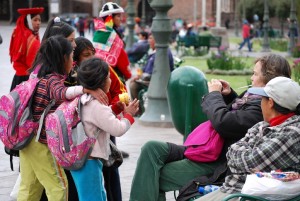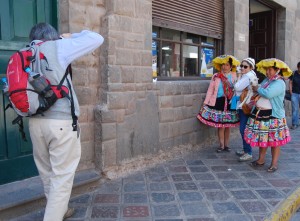Take a Picture Mister

Take a Picture Mister! That is the phrase that the tourists hear while walking around the streets of Cuzco. It comes in the high and delicate voice of cholitas, traditional looking women, and is accompanied by smiles as they hold close their llama, alpaca, or lamb. They offer the tourists the opportunity to take a picture of them but also for the tourist to stand with them and their animals for a photo to document their being in a different place and time.
With their colorful, indigenous dress there women are more than a tourist attraction, they are persons who represent our great culture to the outside. They stand with the most representative animals of the Andes, llamas and alpacas. These women place themselves in the parts of the old city that get the most tourist traffic so that the tourists can take their picture. They are the image of Cuzco.
The great majority of tourists are enchanted by them. For the visitors it is a unique experience to stand with them for a few minutes, to be inserted in the image of a different, exotic and monumental culture even if for only a few seconds. The women’s children enchant the tourists with their cute smiles and open their heart and gentleness. The baby llamas or sheep they carry beg the tourists to take a picture. Who can resist, after all, a child or a baby animal.

While writing this note I realized I did not know the name in our Cuzco Spanish for these women who everyone knows. So I decided to ask my friends who have worked for many years selling handicrafts and paintings in the colonial core. I just wanted to know what they call these cholitas, women, who have their picture taken.
One of my friends who sells painting that they have always been known in Spanish as “tikipicchur”, because of the way they speak in English the words “take a picture”. It turns out that is the word by which everyone knows them.

To take your picture with these women, children, and animals that represent our culture has no formal price. It only costs what your heart will allow you to give them as a tip or gift. After you take the picture, they hold out their hands and plead for a good tip and an incentive.

You can also expect that after you have given the tip they will look sad and plead for more, no matter what you have given them. This is how they make their living.
I asked my colleagues and others what they think about these cholitas who are in the street having their picture taken with the tourists.
Walter: Hi David. “What did you think about these cholitas who ask to have their picture taken when you first came to Cuzco?”
David: “I was fascinated with their colorful dress that is native to Cuzco.. But I did not like that they would get you to take their picture and then charge you. That has always bothered me, even though I know it’s how they make their living. I guess maybe that is because I came to Cuzco after living in Bolivia and was used to seeing people in indigenous clothing.”

Walter: “I see them every day. I like to see them whenever I am walking down our streets and it makes me happy that they attract and captivate the tourists, giving them memories and good experiences. They are the symbol and image of Cuzco.”
It does seem they are models that represent all that is typical and traditional of Cuzco. Along with their animals they are the essence of this great culture.
Every person who sees them takes away different impressions and experiences from meeting them in Cuzco’s streets.
Very few people in the city dress anymore in traditional clothing. That is why these cholitas stand out so much. But once you get out of the city into the countryside you still find lots of people who wear clothing like this.
These women are from the rural communities of Cuzco, close to the city, and they come in to be part of the tourist attractions and work in this way to support their families.

I have to admit that when taking pictures of them I did it cautiously and quickly so that they would not charge me the tip. Some of them realized I was taking their picture, but since they were posing with tourists they could not break frame and hit me up for the tip. I was laughing a bit inside because I thought they were smiling, wile looking at me out of the corner of their eye wanting to yank my ears off.
Every day you can find these cholitas with their children and animals in Cuzco’s streets by major tourist sites where they wait for you to come and take of picture of themselves with you so that you will take good memories home with you.






This made me feel so much better about our situation with llama pictures!! I was upset that they asked for money AFTER as well, but held out all the coin soles that I had on me and she refused it!! She didn’t speak English but from what I gathered, she was telling me where the store was, with an ATM to get her more. I tried to give her what I had but she wouldn’t take it… It was about 5 soles. I kept thinking she was going to find us on the street again and demand her money, but after reading this I think that I was being naive feeling like I owed her more. She could’ve taken what I offered.